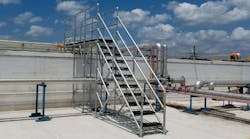Transforming Workplace Safety: Transitioning from Ladders to Stairs
In the quest for safer workplaces, one change is steadily gaining momentum: the transition from ladders to stairs. From warehouses to construction sites, businesses are beginning to recognize the long-term benefits of installing stairs over ladders for routine and emergency access. This shift is not only about reducing accidents but also about enhancing efficiency and ensuring compliance with safety regulations.
The Risk with Ladders
Ladders have been a common fixture in workplaces for providing access to elevated platforms, storage areas, and maintenance spots. However, they pose significant risks. According to safety data, falls from ladders account for a substantial number of workplace injuries and fatalities every year. The primary concerns with ladder use include:
- Instability: Ladders can be unstable, especially when not properly secured or used on uneven ground.
- Falls: Missteps or loss of balance can lead to falls, with potentially severe consequences.
- Overreaching: Workers often overreach while on a ladder, leading to falls or causing the ladder to tip over.
- Carrying Tools: Transporting tools or materials while climbing can lead to loss of balance and subsequent falls.
These risks contribute to a growing consensus among safety professionals that alternatives to ladders should be sought wherever possible.
Stairways to Safety
Stairs offer a safer solution in many instances where ladders were once the norm. With their stable platforms and handrails, stairs reduce the likelihood of falls and provide a more secure method for ascending to and descending from heights. Key advantages include:
- Increased Stability: Stairs are firmly anchored and designed with safety in mind, offering a stable path upward and downward.
- Improved Load Capacity: Stairs can support more weight, allowing employees to carry tools or materials safely.
- Reduced Worker Fatigue: Climbing stairs is generally less physically demanding and more ergonomic than climbing ladders, leading to less fatigue.
- Enhanced Productivity: Workers can move more quickly and comfortably on stairs, boosting efficiency.
The Transition Process
The transition from ladders to stairs involves several stages, beginning with a thorough evaluation of the existing workplace setup.
Assessment and Planning
A comprehensive assessment helps determine where stairs can replace ladders. During this phase, safety professionals consider factors such as the frequency of access required, the height that needs to be accessed, and the physical space available for stair installation.
Design Considerations
When designing stairs, several aspects warrant attention to ensure safety and compliance:
- Tread Depth and Riser Height: To reduce strain on users, stairs should have an appropriate rise-to-run ratio.
- Width: Stairs need to be wide enough to accommodate traffic, including individuals carrying loads.
- Handrails: Proper handrails are crucial for support and balance.
- Landings: Landings should be incorporated where necessary to allow for rest and to maintain a clear line of sight while in use.
Implementation and Training
Once the stairs are installed, it is crucial that workers are trained on using them safely, especially if they’re transitioning from years of ladder use. Training should emphasize correct ascent and descent techniques, the importance of keeping stairs clear of obstructions, and the proper carrying of loads.
Looking Towards OSHA Compliance
In addition to safety benefits, using stairs over ladders is frequently more in line with Occupational Safety and Health Administration (OSHA) regulations, which specify when stairs must be used instead of ladders. For example, OSHA requires stairs for any platform over 12 feet high with regular traffic. Compliance with these regulations is essential to avoid penalties and potential legal issues.
The Cost-Effectiveness Argument
A switch from ladders to stairs might seem like a significant investment. However, the costs should be weighed against the potential savings from reduced workplace injuries, which can be considerable. Fewer injuries mean:
- Less downtime
- Lower workers' compensation claims
- Better productivity
- Improved workplace morale
When you factor in these long-term economic benefits, investing in stairs becomes a sound business decision.
Case Studies and Real-World Applications
Several businesses have successfully transitioned to stairs with positive outcomes. Case studies highlight the reduction in fall incidents, enhanced worker satisfaction, and notable improvements in productivity. When workers feel safer, they are more engaged and motivated, which invariably impacts the bottom line positively.
The Role of Technology
Advancements in construction technology have made the installation of stair systems faster, more cost-effective, and suitable for a variety of applications. Prefabricated stair kits are now available that can be easily integrated into existing structures without extensive modifications.
Conclusion
The shift from ladders to stairs in the workplace is a compelling step towards elevated safety standards. As businesses become more mindful of the risks associated with ladder use, the adoption of stairways will likely continue to rise, spurred by the twin incentives of safety and cost-effectiveness.
Businesses that are proactive in adopting this change not only safeguard their workforce but also set industry standards. As such, the move from ladders to stairs is not just about adherence to safety norms; it is about building a culture of safety that resonates throughout the entire organization. It’s a clear statement that a company values its employees and is dedicated to providing a workplace designed around their well-being.
The conversation about workplace safety is ever-evolving, and as it does, the transition from ladders to stairs is becoming a symbol of a company’s commitment to progress and employee welfare. The steps may be literal, but the climb is towards a loftier goal: an accident-free workplace where safety is paramount and ingrained in every action and design choice.


